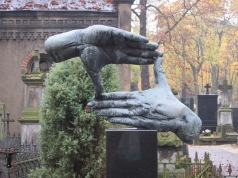• WL100/9: Lutosławski’s carpet
Saturday, 12 January 2013 Leave a comment
Did you know that all of Lutosławski’s works from 1971 onwards were composed as he paced to and fro on a carpet made and sold in the British Isles? And that his grand piano and writing desk stood on it too? You didn’t? Read on!
Below is an undated photo of Lutosławski’s studio. The state of the rucked carpet, the style of the curtains and the blank walls, where subsequently there were bookshelves, allow us to date the photo (first published in 2007) to 1968-70. How can we tell?
In 1968, the Lutosławskis moved from their cramped flat in East Warsaw, where they’d lived since the Second World War, to a spacious detached house in North Warsaw. The first work that Lutosławski composed in his L-shaped first-floor studio was his Cello Concerto. The concerto was premiered in London on 14 October 1970. I discovered the following correspondence at the Paul Sacher Stifting in Basle in 2003:
From Faith Crook (Chester Music) to Lutosławski, 26 October 1970
“Mr Rizza [then MD of Chester Music, London] has passed on to me your note about the carpet you wish to order and get sent to you from Gamages. […] I note that what you require is ‘Tintawn’ No.526 (“White Heather” shade) and you asked for the 108 inch (9 feet) width, but the length you gave of 13 yards 7 inches we find rather puzzling.”
From Lutosławski to Faith Crook, 4 November 1970
“I am very sorry to bother you with that carpet for me. The only excuse to offer is, that it will be a part of the equipment of my working room and thus – serve in a way the purposes of the firm! […] It may seem puzzling, but the room is not a straightforward rectangular one. It is an “L”-form and that is why two strips of different length will have to be pieced together.”
From Faith Crook to Lutosławski, 11 November 1970
Gamage invoice, Holborn, E.C.1
Cost of carpet £65 16s 0d
Carriage £12 15s 0d
Packing £1 10s 0d
Insurance £1 6s 0d
Total £81 7s 0d
Evidently, Lutosławski had gone to London not only for the premiere of the Cello Concerto but also with the measurements of his studio, intent on purchasing a good quality carpet. Wall-to-wall carpets are unusual in Poland, where wooden flooring is usual, so part of his reasoning must have been to do with the room’s acoustics. Gamage’s, which closed in 1972 and was subsequently knocked down, was a huge department store famous for its unusual diversity, from its toy department and Christmas bazaar to a specialist section for motor parts. It evidently had a good carpet showroom too. More particularly, it was in Holborn, barely ten minutes’ walk from Chester Music’s then offices at Eagle Court in E.C.1. Did Lutosławski pass it by accident or was he directed to it by his publishers?
Fast forward to 2002 when, during the ‘Warsaw Autumn’ festival, I was privileged to spend several days, with Nicholas Reyland, examining Lutosławski materials at his house. I had been downstairs in 1981, but I had never seen the ‘working room’ upstairs. We were given extraordinary freedom to research and document what we found. It was exciting, as always, to see where a composer composed. The grand piano had been moved out, but the general layout of the rest of the room was as it had been from the beginning. The photo below was taken from the double doors leading onto the first-floor balcony (compare the 1968-70 photo pointing in the opposite direction).
What was different was the increased shelf-space, the elongated desk area to accommodate the hifi and CDs, and the absence of curtains. The coffee table and flower vase were where they had been in the late 60s, as were the leather easy chairs and sofa, but in a more modern guise.
At the time (2002), I hadn’t found out about the carpet, so took no special photos of it. But here are a couple of clips from other photos. The lower one, taken close to the desk, shows signs of wear and tear, but after over 20 years of Lutosławski’s pacing (he habitually composed standing at the piano, but evidently worked a great deal at his desk also), and a further decade since his death, such signs were hardly surprising.
Yet what was remarkable was how few such patches there were. This must have been a good-quality carpet that Lutosławski chose in London. As soon as I got back from my research to Basle in 2003, I investigated further. And I received this prompt reply from Axminster:
What I didn’t pick up, until it was pointed out today by my friend Colin Stark (who played Epitaph for Lutosławski in Belfast in 1987), is that this carpet was not made at Axminster but in Newbridge, Co. Kildare in Ireland.
It’s nice – if perhaps irrelevant – to think that the music of Lutosławski’s last 23 years (Preludes and Fugue, Les Espaces du sommeil, Mi-parti, Epitaph, Grave, Symphonies 3 and 4, Chains 1-3, Piano Concerto, Chantefleurs et Chantefables, among others) was created as he pondered his next compositional move on a carpet that he bought in London, a creative investment and a material reward, if you like, for one of his greatest artistic achievements.





